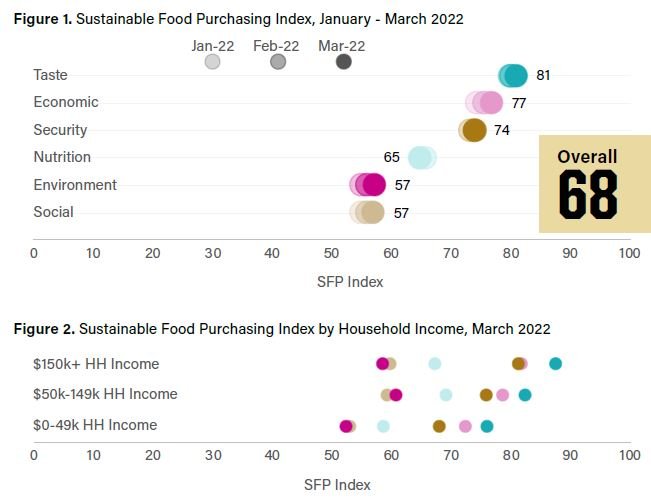The results from the March edition (now issue #3) of our newly launch Consumer Food Insights (CFI) survey from the Center for Food Demand Analysis and Sustainability (CFDAS) at Purdue are now available.
This month, we continued tracking many of the key measures I’ve discussed in previous months. Here are some highlights:
The Sustainable Food Purchasing (SFP) Index was unchanged from last month and it is at 68 out of 100.
There was a slight decrease in the the share of consumers indicating they couldn’t find specific foods at the store (a fall from 25% to 21%) from February to March
Total food spending increased by 8% from last month
At present, we find consumer food demand is price insensitive.
This month’s report has several new analyses and questions. First, we conduced a deeper dive into how responses varied by consumer income. Higher income consumers tend to rate the sustainability of their diets as higher than do lower income consumers, particularly on dimensions related to taste, security, economics, and nutrition. By contrast, there was very little difference in high vs. low income on sustainability dimensions related to social and environment.
In addition to answering questions about how shopping behaviors relate to six sustainability dimensions, we also ask respondents to allocate 100 points to these six dimensions in terms of their importance when buying food. Perhaps not surprisingly, lower income consumers placed a higher weight on affordability than did higher income consumers. By contrast, higher income consumers placed more weight on taste and nutrition than did lower income consumers. There was little income difference in the weight attached to social responsibility, environmental impact, or availability across income categories.
Higher income consumers are happier with their diets and are much less likely to be waiting on their next payment to buy food for their household.
To track whether consumers are beginning to shop in a more price-responsive, or recessionary, manner, we asked if respondents would purchase a basket of brand name groceries priced at $100 or a comparable basket of generic name groceries priced at either $85 or $70 (the amount randomly varied across respondents). Higher income households were much more likely to say they’d choose branded over generic products than lower income consumers. However, for all three income groups, none were particularly sensitive to the change in price of brand vs. generic.
There are also income differences in support for food policies. Lower income households showed more support for policies like increasing funding for ag research, but they showed less support for fast food zoning and sweetened beverage taxes as compared to higher income consumers.
We added several new questions this month related to how food away from home spending varies by different type of outlet (and by in-person vs. drive through vs. delivery), and we added questions about consumers’ beliefs about various food-related issues. There was strong agreement that climate change will impact food prices, and less agreement that GMOs are safe or that plant-based milk is healthier than dairy milk. Perhaps an indication of chemophobia or general distrust of unknown substances, 26% agreed that food with deoxyribonucleic acid (i.e., DNA) is unsafe to eat.
There’s a lot more in the report. Check the whole thing out here.





